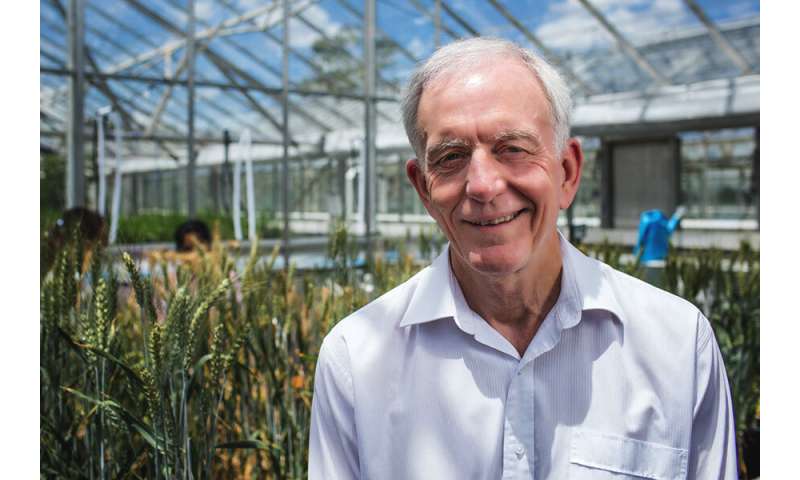Robots working in abattoirs, sky-high vertical farms, more gene-edited foods in our supermarkets and automated farming systems could all help guarantee food supply in the next pandemic.
by University of Queensland

Robert Henry is a Professor of Innovation at the University of Queensland, Australia, and Director of the Queensland Alliance for Agriculture and Food Innovation (QAAFI). Credit: QAAFI
University of Queensland Professor Robert Henry said the technologies had all been in various stages of planning prior to COVID-19, but food producers would now be moving much faster to prepare for the next pandemic.
"Food processing facilities like meat works have had to close due to a staff member being infected with the coronavirus, and all food processing industries where you have workers in small confined spaces are similarly at risk," Professor Henry said.
Professor Henry, who is the Director of the Queensland Alliance for Agriculture and Food Innovation (QAAFI), said roboticized abattoirs and automated harvesting and production facilities would also reduce the risk of transmission of pathogens among workers but also the spread of viruses via the food itself.
"COVID does not seem to be transmissible from an infected human touching food but a future pandemic virus might be transmitted this way, so automating the food supply chain reduces this risk.
"It also minimizes reliance on human workers that are not available due to migration restrictions and border closures."
Professor Henry said protected cropping, including vertical farms—or growing food in vertically stacked layers similar to a skyscraper building—would optimize plant growth and enable control over climate variations, chemical inputs and water resources.
"There will have to be policies that drive consumer acceptance of gene edited foods, which some consumers consider as GMOs.
"Advanced technologies need to be adopted globally, in each region, to deliver local food production capability that could provide secure sources of food in future pandemics.
"We will need to design crops to suit automated systems—for example for fruit to grow in places where it can be harvested robotically."
Professor Henry said the ongoing COVID-19 pandemic made it difficult to fully assess the impact on agriculture and food supply.
He said despite growing stocks of foods such as cereals, it was estimated the number of people facing a food crisis will grow from 135 million to 265 million by the end of 2020.
"It may seem to those of us in Western countries that the only impact on food supply has been a rush on pasta and rice in the supermarket and home-baking but the loss of income caused by the pandemic has hit some countries in Africa hard.
'We are in a situation where we have food surpluses while there has been a doubling in the number of people who can't afford to eat—and the situation is likely to get worse."Professor Henry said increased investment in agricultural research and development would support enhanced food security.
University of Queensland Professor Robert Henry said the technologies had all been in various stages of planning prior to COVID-19, but food producers would now be moving much faster to prepare for the next pandemic.
"Food processing facilities like meat works have had to close due to a staff member being infected with the coronavirus, and all food processing industries where you have workers in small confined spaces are similarly at risk," Professor Henry said.
Professor Henry, who is the Director of the Queensland Alliance for Agriculture and Food Innovation (QAAFI), said roboticized abattoirs and automated harvesting and production facilities would also reduce the risk of transmission of pathogens among workers but also the spread of viruses via the food itself.
"COVID does not seem to be transmissible from an infected human touching food but a future pandemic virus might be transmitted this way, so automating the food supply chain reduces this risk.
"It also minimizes reliance on human workers that are not available due to migration restrictions and border closures."
Professor Henry said protected cropping, including vertical farms—or growing food in vertically stacked layers similar to a skyscraper building—would optimize plant growth and enable control over climate variations, chemical inputs and water resources.
"There will have to be policies that drive consumer acceptance of gene edited foods, which some consumers consider as GMOs.
"Advanced technologies need to be adopted globally, in each region, to deliver local food production capability that could provide secure sources of food in future pandemics.
"We will need to design crops to suit automated systems—for example for fruit to grow in places where it can be harvested robotically."
Professor Henry said the ongoing COVID-19 pandemic made it difficult to fully assess the impact on agriculture and food supply.
He said despite growing stocks of foods such as cereals, it was estimated the number of people facing a food crisis will grow from 135 million to 265 million by the end of 2020.
"It may seem to those of us in Western countries that the only impact on food supply has been a rush on pasta and rice in the supermarket and home-baking but the loss of income caused by the pandemic has hit some countries in Africa hard.
'We are in a situation where we have food surpluses while there has been a doubling in the number of people who can't afford to eat—and the situation is likely to get worse."Professor Henry said increased investment in agricultural research and development would support enhanced food security.
More information: Robert Henry, Innovations in Agriculture and Food Supply in Response to the COVID-19 Pandemic, Molecular Plant (2020). DOI: 10.1016/j.molp.2020.07.011
Journal information: Molecular Plant
Provided by University of Queensland
No comments:
Post a Comment